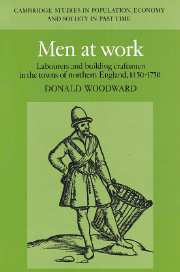Book contents
- Frontmatter
- Contents
- List of tables
- List of appendices
- Preface
- List of abbreviation
- 1 Introduction
- 2 Building craftsmen at work
- 3 The life-cycle of building craftsmen
- 4 Labourers
- 5 Conditions of work for labourers and building craftsmen
- 6 Wage rates in the northern towns
- 7 Towards an understanding of living standards
- Appendices
- Bibliography
- Index
- Cambridge Studies in Population, Economy and Society in Past Time
2 - Building craftsmen at work
Published online by Cambridge University Press: 15 October 2009
- Frontmatter
- Contents
- List of tables
- List of appendices
- Preface
- List of abbreviation
- 1 Introduction
- 2 Building craftsmen at work
- 3 The life-cycle of building craftsmen
- 4 Labourers
- 5 Conditions of work for labourers and building craftsmen
- 6 Wage rates in the northern towns
- 7 Towards an understanding of living standards
- Appendices
- Bibliography
- Index
- Cambridge Studies in Population, Economy and Society in Past Time
Summary
The memorandum of c.1573 on the Statute of Artificers laid down a list of trades which could recruit their apprentices from any social group: they included bricklayers, brickmakers, tilers, slaters, tilemakers, carpenters, millwrights, sawyers, masons, plasterers, and smiths. It was explained that: ‘These seem to be such trades as are for divers respects to be planted as well in country towns and villages as in cities and towns corporate, and be indeed such occupations as are most laboursome and painful, whereof some do not much differ from the trade of labourers.’ Indeed, there were times when those who believed themselves to possess a skill which set them above the common herd of labourers were pushed down into a lower stratum: at Coventry in 1517 it was ordered that rough masons and daubers were to be treated as mere labourers. No doubt it was difficult for observers from higher social positions to perceive clearly the differences between labourers and building craftsmen, as at Durham in the 1580s when the clerk of works referred to the ‘charges of wrights and other labourers at Stockton’. But tedious and back-breaking though their work often was, craftsmen were more skilled than labourers and, especially in the larger towns, they strove to protect their territories of expertise through the agency of the craft gilds.
- Type
- Chapter
- Information
- Men at WorkLabourers and Building Craftsmen in the Towns of Northern England, 1450–1750, pp. 15 - 52Publisher: Cambridge University PressPrint publication year: 1995



